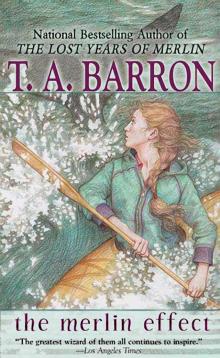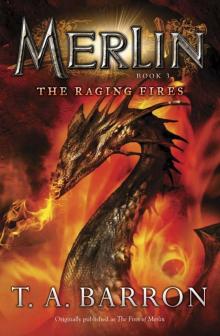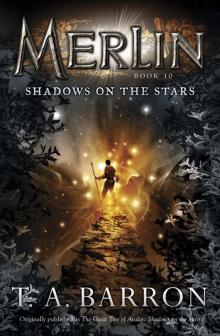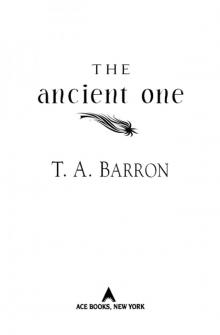- Home
- T.A. Barron
The Seven Songs
The Seven Songs Read online
I am supposed to be a wizard?
I shambled down to the bottom of the stairwell. Despondently, I leaned close to the wall. Reaching out my hand, I touched the very first rune with the tip of my finger. It looked something like a squarish sunflower wearing a long, shaggy beard. Slowly, I traced its curves and creases, trying yet again to sense even a glimmer of its meaning.
Nothing.
I dropped my hand. Perhaps it was a matter of confidence. Of belief. I was born to be a wizard, wasn’t I? Tuatha himself said so. I am his grandson. His heir.
Again I touched the first rune.
Again I sensed nothing.
Speak to me, rune! I command you! Still nothing. I slammed my fist against the wall. Speak to me, I say! That is my command!
Another painful moan echoed down the stairwell. My stomach knotted. I drew a slow, unsteady breath. If not for me, then for her! She will die if I can’t find some way to learn your secret. A tear drifted down my cheek. Please. For her.
PUFFIN BOOKS
Published by the Penguin Group
Penguin Young Readers Group, 345 Hudson Street, New York, New York 10014, U.S.A.
Penguin Group (Canada), 90 Eglinton Avenue East, Suite 700, Toronto, Ontario, Canada M4P 2Y3
(a division of Pearson Penguin Canada Inc.)
Penguin Books Ltd, 80 Strand, London WC2R 0RL, England
Penguin Ireland, 25 St Stephen’s Green, Dublin 2, Ireland (a division of Penguin Books Ltd)
Penguin Group (Australia), 250 Camberwell Road, Camberwell, Victoria 3124, Australia
(a division of Pearson Australia Group Pty Ltd)
Penguin Books India Pvt Ltd, 11 Community Centre, Panchsheel Park, New Delhi - 110 017, India
Penguin Group (NZ), 67 Apollo Drive, Rosedale, Auckland 0632, New Zealand
(a division of Pearson New Zealand Ltd.)
Penguin Books (South Africa) (Pty) Ltd, 24 Sturdee Avenue,
Rosebank, Johannesburg 2196, South Africa
Registered Offices: Penguin Books Ltd, 80 Strand, London WC2R 0RL, England
First published in the United States of America as The Seven Songs of Merlin by Philomel Books,
a division of Penguin Young Readers Group, 1997
Paper-over-board edition, 2007
Published as The Seven Songs by Puffin Books, a division of Penguin Young Readers Group, 2011
Patricia Lee Gauch, editor
Text copyright © Thomas A. Barron, 1997
Map illustration copyright © Ian Schoenherr, 1996
All rights reserved
THE LIBRARY OF CONGRESS HAS CATALOGED THE PHILOMEL BOOKS EDITION AS FOLLOWS:
Barron, T. A. The seven songs of Merlin / T. A. Barron.
“Volume two of ‘The lost years of Merlin.’”
p. cm.
Summary: Having stumbled upon his hidden powers, the young wizard Merlin voyages to the Otherworld in his quest to find himself and the way to the realm of the spirit.
ISBN : 978-0-399-25021-7 (hc)
[1. Merlin (Legendary character) —Fiction. 2. Wizards—Fiction. 3. Fantasy.]
I. Title
PZ7.B27567Sev
1997 [Fic]—dc21 97-9619 CIP AC
Puffin Books ISBN 978-0-14-241920-5
Design by Gunta Alexander
Text set in Galliard
Printed in the United States of America
Except in the United States of America, this book is sold subject to the condition that it shall not, by way of trade or otherwise, be lent, re-sold, hired out , or otherwise circulated without the publisher’s prior consent in any form of binding or cover other than that in which it is published and without a similar condition including this condition being imposed on the subsequent purchaser.
The publisher does not have any control over and does not assume any responsibility for author or third-party Web sites or their content.
This book is dedicated to
Currie
who sings her life as if it were a verse
of the seventh Song
with special appreciation to
Ross
age two, who sees so well with his heart
AUTHOR’S NOTE
Sometimes, in the long hours before dawn, I lie awake, listening. To the boughs of cottonwood, stirring in the wind. To the great horned owl, hooting quietly. And, on rare occasions, to the voice of Merlin, whispering. Before I could even begin to hear Merlin’s voice—let alone hear it clearly enough to tell the tale of his lost youth—I needed to learn a little. And to unlearn a lot. Most of all, I needed to listen with care, using more than just my ears. For this wizard is full of surprises.
The Lost Years of Merlin, volume one of this sequence, revealed the strange events that began his years lost from time. Why should those years have disappeared from the traditional lore, only to come to light now, centuries later? The answer may have something to do with the profound changes—and terrible pain—that Merlin himself experienced in that period. Yet those years proved to be exceptionally important ones for the person who would one day serve as the mentor to King Arthur.
The story of Merlin’s lost years began when, as a boy at the very edge of death, he washed ashore on the rugged coast of Wales. The sea had robbed him of everything he had once known. Completely unaware that he would, one day, become the greatest wizard of all time, he lay tormented by the shadows of things he could not recall. For he had no memory. No home. And no name. From Merlin’s own words, we can feel the lasting trauma, and hidden hope, of that day:
If I close my eyes, and breathe to the rolling rhythm of the sea, I can still remember that long ago day. Harsh, cold, and lifeless it was, as empty of promise as my lungs were empty of air.
Since that day, I have seen many others, more than I have the strength left to count. Yet that day glows as bright as the Galator itself as bright as the day I found my own name, or the day I first cradled a baby who bore the name Arthur.
Perhaps I remember it so clearly because the pain, like a scar on my soul, will not disappear. Or because it marked the ending of so much. Or, perhaps, because it marked a beginning as well as an ending: the beginning of my lost years.
Now the young Merlin’s story continues. He may have solved the riddle of the Dance of the Giants, but a dark knot of riddles lies just ahead. Whether he can successfully pull them apart, in time to complete his quest, remains to be seen. The challenge is enormous. While Merlin has stumbled upon his hidden powers, he has not nearly mastered them. While he has heard some of the wisdom of the Druids, the Greeks, and the Celts, he has only begun to understand it. And while he has discovered his own name, and a hint of his true destiny, he has yet to find the secret of his innermost self.
In short, he does not yet know what it means to be a wizard.
If he is to find the wizard in himself, the young Merlin, who has already lost so much, must lose something more. Along the way, he may gain a few things, as well. He may finally learn the truth about his friend Rhia. He may grasp the difference between sight and insight. He may even find, to his sorrow, that he holds both the dark and the light within himself—even as he finds, to his joy, that he also holds other qualities often called opposites: youth and age, male and female, mortal and immortal.
Legendary heroes sometimes ascend through the three levels of self, world, and Otherworld. First he or she must discover the hidden pathways within. Next the hero must triumph over the enemies of mortal life on Earth. Finally, he or she must confront the perils and possibilities of the spirit. In a sense, Merlin alters this traditional pattern by attempting to voyage to the Otherworld in this book, only the second volume of the sequence. But Merlin, as we have seen, is not very good at following the rules. The truth is that in this book, as in the oth
ers, Merlin finds himself exploring all three levels at once.
Yet it is the Otherworld, the realm of the spirit, that holds the key to this quest. It is a mysterious place, rarely visited by mortals, full of danger as well as inspiration. If Merlin can somehow master the Seven Songs of Wizardry, defeat the same forces that destroyed his own grandfather, and discover the secret of the Otherworld Well, he could indeed find his way to the spiritual realm. If he does, he may meet both the mysterious Dagda and the treacherous Rhita Gawr . . . and whatever might be left of his loyal friend Trouble.
And, in the process, he may find something more. As W. B. Yeats once wrote, humanity has always yearned to find some connection with the cosmic order, “to reunite the perception of the spirit, of the divine, with natural beauty.” That is why the young Merlin, who first sensed his own powers of renewal by riding out a storm in the branches of a tree, struggles to make such a connection as he follows the winding path to wizardry.
This portion of Merlin’s journey begins where the last one ended, on the legendary isle of Fincayra. The Celts believed it to be an island beneath the waves, a halfway point between this world and the Otherworld. An omphalos, the Greeks might say. But Fincayra’s best description came from Elen, Merlin’s mother, who called it simply an in between place. Like the mist, which is neither quite water nor quite air, Fincayra is neither quite mortal nor quite immortal. It is something in between.
Merlin, too, is something in between. He is not truly a man, yet not truly a god. He is not really old, yet not really young. Carl Jung would have found him a compelling character, for Merlin’s mythic powers sprang from both the unconscious and the conscious, just as his wisdom flowed from both nature and culture.
It is no accident that the most ancient tales of Merlin give him a saintly mother and a demonic father, metaphors for the light and the dark sides within us all. And Merlin’s greatest wisdom came not from expelling or eliminating his dark side, but rather from embracing it, owning it as part of himself. Ultimately, it is this sense of human frailty, along with human possibility, that makes Merlin the fitting mentor for King Arthur.
I remain deeply grateful to all those people named in the Author’s Note of the first volume, most especially my wife and best friend, Currie, and my immensely wise editor, Patricia Lee Gauch. In addition, I would like to thank Lloyd Alexander, whose works continue to inspire us all; Susan Cullinan, who understands the wisdom of humor; and Sasha, our gentle Labrador, who often warms my feet as I write.
Once again, Merlin whispers. Let us listen, but with care. For this wizard, as we know, is full of surprises.
T. A. B.
I was taken out of my true self.
I was a spirit and knew . . .
the secrets of nature,
bird flight,
star wanderings,
and the way fish glide.
—Merlin,
quoted in Geoffrey of Monmouth’s
twelfth-century book VITA MERLINI
PROLOGUE
How the centuries have flown . . . Faster, by far, than the brave hawk who once bore me on his back. Faster, indeed, than the arrow of pain that lodged in my heart on the day I lost my mother.
Still I can see the Great Council of Fincayra, gathering in the circle of standing stones, all that remained of the mighty castle after the Dance of the Giants. Not for many ages had a Great Council been called on that spot; not for many ages would one be called again. Several difficult questions awaited resolution by the delegates, including how to punish the fallen monarch, and whether or not to choose a successor. But the gravest question of all was what to do with the enchanted Treasures of Fincayra, especially the Flowering Harp.
I cannot forget how the meeting began. Nor, hard as I try, can I forget how it ended.
A cluster of shadows more dark than the night, the circle of stones stood erect on the ridge.
No stirring, no sound, disturbed the night air. A lone bat swooped toward the ruins, then veered away, perhaps out of fear that the Shrouded Castle might somehow rise again. But all that remained of its towers and battlements was the ring of standing stones, as silent as abandoned graves.
Slowly, a strange light began rippling over the stones. It was not the light of the sun, still hours from rising, but of the stars overhead. Bit by bit the stars grew steadily brighter. It seemed as if they were somehow drawing nearer, pressing closer to the circle, watching with a thousand eyes aflame.
A broad-winged moth, as yellow as butter, alighted on one of the stones. Soon it was joined by a pale blue bird, and an ancient horned owl missing many feathers. Something slithered across a fallen pillar, keeping to the shadows. A pair of fauns, with the legs and hoofs of goats and the chests and faces of boys, gamboled into the clearing inside the circle. Next came the walking trees, ashes and oaks and hawthorns and pines, sweeping across the ridge like a dark green tide.
Seven Fincayran men and women, their eyes full of wonder, stepped into the circle alongside a band of red-bearded dwarves, a black stallion, several ravens, a pair of water nymphs raucously splashing each other in a pool beneath one of the stones, a speckled lizard, popinjays, peacocks, a unicorn whose coat shone as white as her horn, a family of green beetles who had brought their own leaf to sit on, a doe with her fawn, a huge snail, and a phoenix who stared at the crowd continuously without ever blinking.
As more delegates arrived, one of the Fincayrans, a shaggy-headed poet with a tall brow and dark, observant eyes, stood watching the scene unfold. In time, he stepped over to a tumbled pillar and sat down next to a robust girl dressed in a suit of woven vines. On her other side sat a boy, holding a twisted staff, who looked older than his thirteen years. His eyes, blacker than charcoal, seemed strangely distant. He had recently taken to calling himself Merlin.
Screeching and fluttering, buzzing and growling, hissing and bellowing filled the air. As the sun rose higher, painting the circle of stones with golden hues, the din rose higher as well. The cacophonous noise subsided only once, when an enormous white spider, more than twice as big as the stallion, entered the ring. As the other creatures hushed, they moved quickly aside, for while they might have felt honored to be joined by the legendary Grand Elusa, they also suspected that she might well have worked up an appetite on her journey from her crystal cave in the Misted Hills. She had no difficulty finding a seat.
As the Grand Elusa positioned herself on a heap of crushed rock, she scratched the hump on her back with one of her eight legs. Using another leg, she pulled a large, brown sack off her back and placed it by her side. Then she glanced around the circle, pausing for an instant to gaze at Merlin.
Still more came. A centaur, wearing a beard that fell almost down to his hooves, strode solemnly into the ring. A pair of foxes, tails held high, pranced in his wake, followed by a young wood elf with arms and legs nearly as wispy as her nut brown hair. A living stone, splotched with moss, rolled into the center, barely missing a slow-moving hedgehog. A swarm of energetic bees hovered close to the ground. Near the edge, a family of ogres viciously scratched and bit each other to pass the time.
And still more came, many Merlin could not identify. Some looked like bristling bushes with fiery eyes, others resembled twisted sticks or clumps of mud, and still others seemed invisible but for a vague shimmer of light they cast on the stones. He saw creatures with bizarre faces, dangerous faces, curious faces, or no faces at all. In less than an hour, the silent ring of stones had transformed into something more like a carnival.
The poet, Cairpré, did his best to answer Merlin’s questions about the strange and wondrous creatures surrounding them. That, he explained, was a snow hen, who remained as elusive as a moonbeam. And that, a glynmater, who ate food only once every six hundred years—and then only the leaves of the tendradil flower. Some creatures he could not recognize were known by the leaf-draped girl, Rhia, from her years in Drama Wood. Yet there remained several that neither Cairpré nor Rhia could identify.
Th
at came as no surprise. No one alive, except possibly . . . the Grand Elusa, had ever seen all of the diverse residents of Fincayra. Soon after the Dance of the Giants had occurred, toppling the wicked king Stangmar and destroying his Shrouded Castle, the call had risen from many quarters to convene a Great Council. For the first time in living memory, all the mortal citizens of Fincayra, whether bird or beast or insect or something else entirely, were invited to send representatives to an assembly.
Almost every race had responded. The few missing ones included the warrior goblins and shifting wraiths, who had been driven back into the caves of the Dark Hills after the defeat of Stangmar; the treelings, who had disappeared from the land long ago; and the mer people, who inhabited the waters surrounding Fincayra but could not be found in time to be invited.
After studying the crowd, Cairpré observed sadly that the great canyon eagles, one of the oldest races on Fincayra, were also not present. In ancient times the stirring cry of a canyon eagle always marked the beginning of a Great Council. Not this time, however, since the forces of Stangmar had hunted the proud birds to extinction. That cry, Cairpré concluded, would never again echo among the hills of this land.
Merlin then glimpsed a pale, bulbous hag with no hair on her head and no mercy in her eyes. He shivered with recognition. Although she had taken many names across the ages, she was most often called Domnu, meaning Dark Fate. No sooner had he caught sight of her than she vanished into the throng. He knew she was avoiding him. He also knew why.
Suddenly a great rumbling, even louder than the noise of the assembly, shook the ridge. One of the standing stones wobbled precariously. The rumbling grew still louder, causing the stone to crash to the ground, almost crushing the doe and fawn. Merlin and Rhia looked at each other—not with fright, but with understanding. For they had heard the footsteps of giants before.

 Giant
Giant Doomraga's Revenge
Doomraga's Revenge A Wizard's Wings
A Wizard's Wings Tree Girl
Tree Girl The Mirror of Fate
The Mirror of Fate The Great Tree of Avalon
The Great Tree of Avalon The Seven Songs
The Seven Songs The Merlin Effect
The Merlin Effect Atlantis Lost
Atlantis Lost Ultimate Magic
Ultimate Magic Atlantis in Peril
Atlantis in Peril The Dragon of Avalon
The Dragon of Avalon Heartlight
Heartlight The Eternal Flame
The Eternal Flame The Raging Fires
The Raging Fires Shadows on the Stars
Shadows on the Stars Merlin: The Book of Magic
Merlin: The Book of Magic The Lost Years
The Lost Years The Ancient One
The Ancient One Atlantis Rising
Atlantis Rising